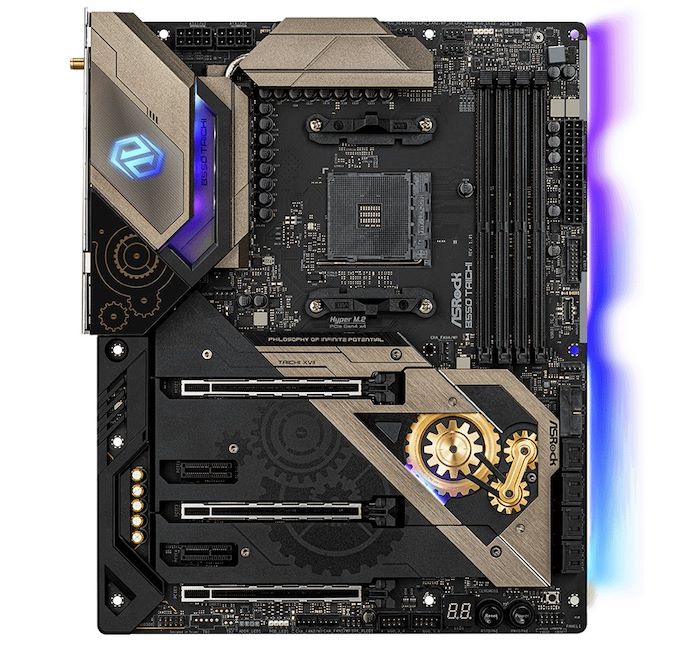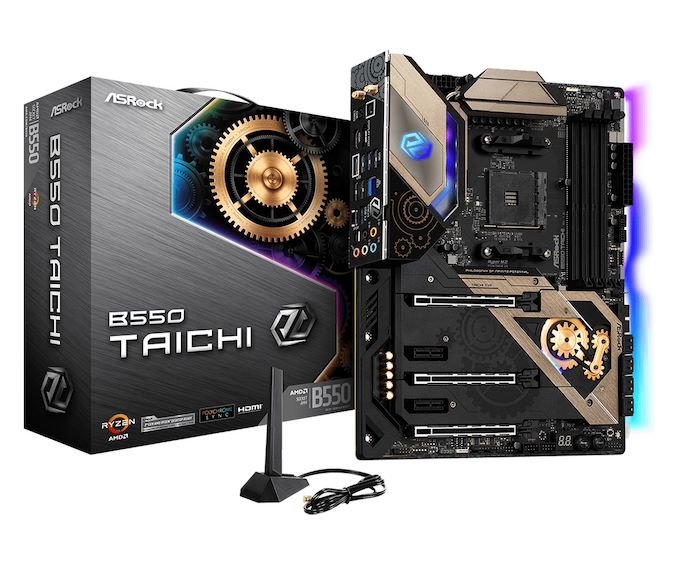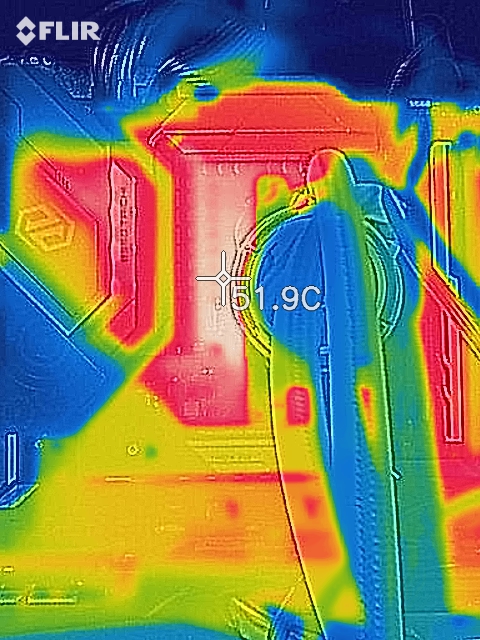ASRock B550 Taichi Review: The $300 B550 Motherboard with Chutzpah
by Gavin Bonshor on August 21, 2020 3:30 PM EST- Posted in
- Motherboards
- AMD
- ASRock
- Taichi
- AM4
- Ryzen 3000
- Ryzen 3700X
- Ryzen 4000
- B550
- B550 Taichi
_678x452.jpg)
Outside of its Aqua series of motherboards, which come with exquisitely crafted monoblocks, ASRock's Taichi brand has been a critical part of the company's offerings in the land of premium motherboards. The ASRock B550 Taichi sits at the top of its product stack and features an impressive quality feature set. Some of the most notable features include a large 16-phase power delivery, eight SATA ports, dual M.2 slots, an Intel 2.5 GbE Ethernet controller, and an Intel Wi-Fi 6 interface. At $300 it comes equal in price with the X570 version, which leaves questions on the table as to which one is actually worth the money.
When AMD first released the B550 chipset, a lot of fanfare was made about the high launch price of some models. For what has been usually considered a 'budget' chipset, some of the more premium B550 models cost more than some of the X570 models, which featured full support for PCIe 4.0 to add-in cards and the chipset. The B550 chipset has less PCIe 4.0 support than X570, with only the top full-length PCIe slot and one PCIe M.2 slot operating at PCIe 4.0, while the rest of the slots and chipset operate at PCIe 3.0. The trade-off is downstream bandwidth from the chipset as well as power, because the X570 requires a fan to keep that PCIe 4.0 chipset cool. Ultimately X570 requires 'more' to be fully enabled than B550, so it comes as a bit of surprise when the B550 and X570 models sit on equal pricing.
The ASRock B550 Taichi
Even with what has been said above, the ASRock B550 Taichi has all the hallmarks of a premium AM4 model with a solid array of controllers, ports, and power delivery.
Armed with its unique Taichi inspired design, the ASRock B550 Taichi follows a bronze and black color scheme with three customizable RGB LED zones. ASRock has installed the B550 Taichi with a large sixteen phase power delivery, which performs very well in our thermal testing. Unique to the ASRock range, the B550 Taichi is the only board where the top two PCIe slots support a PCIe 4.0 x8/x8 configuration - out of all other B550 boards, only two others have this feature.
Another solid benefit of the Taichi is that it includes a BIOS Flashback controller which allows users to update the firmware without a CPU installed. This is useful for when AMD launches Ryzen 4000 and a firmware update will be required to use the new Zen 3 processors. Some of the board's other core features include 2.5 GbE networking, Wi-Fi 6, and a premium audio codec with an assisting amplifier designed to bolster the quality of the front panel audio header.
After running our benchmarking suite, the ASRock B550 proved a consistent and solid performer in our testing. It displayed competitive performance in our system tests with strong power consumption figures in all three of our power tests, with a decent non-UEFI POST time of 20.6 seconds at default settings. In our CPU and gaming tests, the B550 Taichi performed competitively against other AM4 boards tested with our testbed Ryzen 7 3700X processor.
Our overclocking testing proved resourceful with a maximum stable overclock of 4.3 GHz with our Ryzen 7 3700X processor. Overall VDroop control was consistent throughout our testing, as was the performance in our POV-Ray benchmark testing. We saw equally impressive performance in our VRM thermal testing with the Taichi beating some of the more advanced and much more expensive X570 models. This is due to a more efficient power delivery design, as well as a solid pair of heatsinks which are interconnected via a single heat pipe for better heat dissipation. This is ultimately the reason why, despite being B550, this Taichi costs the same as the X570: better thermals and better power delivery.
The ASRock B550 Taichi as it stands is one of the most expensive B550 models with an MSRP of $300. This puts it up against ASRock's own X570 Taichi which currently costs $300 at Newegg. This puts the B550 Taichi in an awkward position in terms of value, with the X570 offering more raw features. However the B550 Taichi offers an alternative is the slightly larger power delivery (16-phase versus 14-phase), and an Intel 2.5 GbE Ethernet controller whereas the X570 Taichi is equipped with a standard Gigabit port.
Read on for our extended analysis and comparison tests.













61 Comments
View All Comments
Marlin1975 - Friday, August 21, 2020 - link
But why? Just get a x570 board with more features.The b550 is supposed to be a cheaper board to the x570s.
29a - Friday, August 21, 2020 - link
I ask the same thing, why? Why didn't they just use the 570?peevee - Monday, August 24, 2020 - link
$300 board, why? I have bought $50 boards, and it was at the time when north bridge was still on a separate chip. Admittedly, my last build is from 2011... with 2600k... still works, only Ethernet has died (and was replaced with a cheap card, as it should have been).Samus - Friday, August 28, 2020 - link
Premium boards generally do pay off. Every premium board I've purchased lasted over a decade with 0 issues. Every cheap board I bought had at least 1 issue within a few years.Example: Asus P6X58D ($300 in 2008, retired LAST YEAR)
Example Asrock H87M-ITX ($120 in 2013, the cheapest H87 ITX board, retired 3 years later when it wouldn't POST half the time during a reboot\cold boot)
Gigaplex - Tuesday, August 25, 2020 - link
Where I live, the Gigabyte B550I Aorus Pro AX is 20% cheaper than the Gigabyte X570 I Pro Wifi, and includes 2.5Gbit ethernet which the X570 doesn't have. It's a no-brainer for me, B550 it is.desii - Friday, August 21, 2020 - link
>why?Chipset fan.
bananaforscale - Saturday, August 22, 2020 - link
Chipset fan, that1) doesn't even come on unless required and
2) is required only if you stress test PCIe 4 drives.
The fan is not an issue.
WaltC - Saturday, August 22, 2020 - link
Doesn't make any noise, either...;) The chipset fan nonsense has always been a red herring, imo.Spunjji - Monday, August 24, 2020 - link
I understood the trepidation from some people, but it's clear that most of it was FUD from Intel stans.TheinsanegamerN - Tuesday, August 25, 2020 - link
Not really nonsense when it's been demonstrated that 570 can easily be cooled by passive heatsinks and there is a very good reason people loathe those tiny fans. Tiny fans didnt become super reliable overnight.